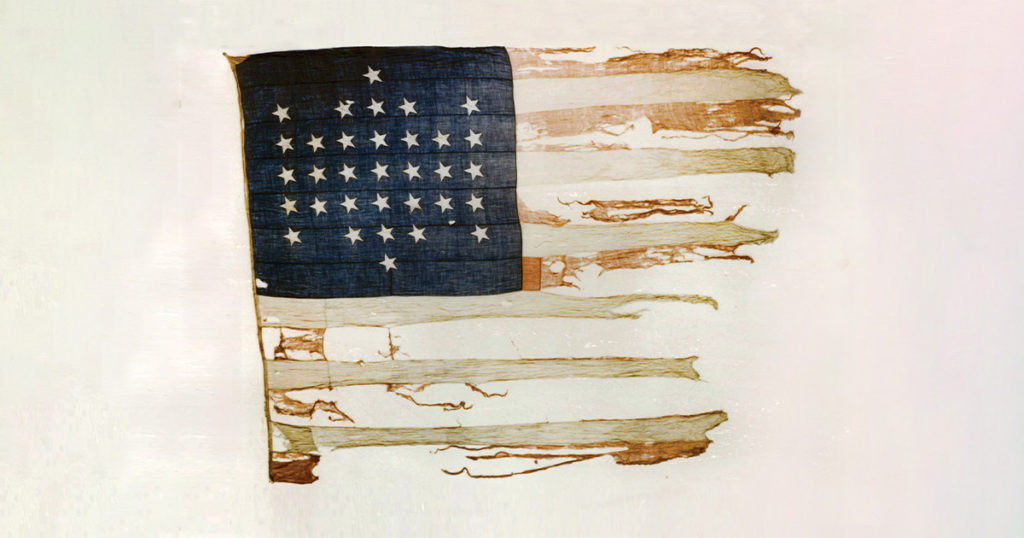
American Republics: A Continental History of the United States, 1783–1850 by Alan Taylor; Norton, 554 pp., $35
“Before the war, it was said ‘the United States are,’ ” noted the late novelist and Civil War historian Shelby Foote. “Grammatically, it was spoken that way and thought of as a collection of independent states. And after the war, it was always ‘the United States is.’ … And that sums up what the war accomplished. It made us an ‘is.’ ” This would be a remarkable testament to the reconciliation that followed the Civil War if only it were true. Pace Foote, conceptualizations of the United States in the singular and the plural were in wide circulation during the early republic, and though the singular would eventually become conventional, it was a slow and uneven process—and one that stretched long past the 1860s.
Nevertheless, Alan Taylor’s American Republics demonstrates convincingly why any characterization of the United States in the singular during the fractious, unstable, and violent period between 1783 and 1850 could not have been anything more than a convenient fiction. In his characteristically illustrative and evocative prose, Taylor, a history professor at the University of Virginia and two-time Pulitzer Prize winner, explores the restless drive of the United States for new territory animated by mutually reinforcing aims: to ward off British and Spanish imperial rivals; to provide a pressure valve to release the class and ethnic tensions generated by a skyrocketing population; to remove, if not wholly eradicate, indigenous peoples who blocked easy access to resource-rich lands; and to strike political compromises that would sustain a fragile peace between slave and free states. There’s no mistaking Taylor’s portrayal of aggressive expansionism with the myth of endless virgin land just waiting for industrious white settlers to harness its fecundity. What American Republics offers instead is a more faithful, if less flattering, view of the “ragged reality” of early America, where chronic warfare, formidable external and internal enemies, and tenuous alliances were a constant source of grinding insecurity and instability.
As Taylor reminds us, even after the Revolutionary War, and even with the adoption of the Constitution, “few people thought and acted as Americans,” and he shows how this weak sense of national belonging persisted during the bumpy decades of the early 19th century. Despite their deep history in what whites called “America,” indigenous peoples were never welcomed into American society. Nor were they interested: they struggled instead to retain their ancestral lands, ways of life, and tribal sovereignty. Free Blacks pressed for recognition as Americans, but their humanity was no more recognized than that of their enslaved kin. Even white citizens’ primary attachment was not to America but to their state, region, party, self-interest, and bottom line. According to Taylor, “an American national identity emerged later, slowly, painfully, and partially” and coalesced around the only thing most white Americans could agree on: white supremacy. From first lady Sarah Polk, who “reinforced James’s commitment to white supremacy as God’s will,” to the Senate Committee on Indian Affairs, which maintained that Indians “are on the outside of us,” to the author of an anti-Hispanic exclusionary tax policy who insisted that he could “maintain a better stomach at the killing of a Mexican than at the crushing of a body louse,” white Americans carved out a sense of national belonging by perpetuating their own racial dominance.
Many 19th-century Americans, Taylor writes, felt that union was the only way to “preserve free government on a continental scale.” But others worried about the implications of consolidated national power. No battle, no treaty, no law, no soaring rhetoric seemed to adequately answer the gnawing question of whether the states were knit together by too few or too many shared interests, priorities, and enemies. From the vantage point of one North Carolina delegate in the decade after the Revolutionary War, the “Confederated compact is no more than a rope of sand, and if a more efficient Government is not obtained, a dissolution of the Union must take place.” By 1832, things didn’t look any better to Chief Justice John Marshall: “The Union has been preserved thus far by miracles. I fear they cannot continue.” At issue was not just whether union was practicable but whether it was desirable. We may expect such skepticism from a slaveholding southern politician, but Ralph Waldo Emerson was likewise unconvinced. “Nothing seems to me more bitterly futile than this bluster about the Union,” he lamented after passage of the 1850 Fugitive Slave Law.
If union inspired ambivalence, democracy brought fear and trembling. Taylor makes clear that “contrary to popular mythology, most of the founders did not intend to create a democracy. Instead, they designed a national republic to restrain state democracies.” Both Federalists and Republicans were keenly aware that all great republics in history eventually collapsed, and this impelled them to consider how little democracy they could get away with to inoculate the fledgling nation against certain ruin. After 1815, as more states expanded the franchise among white men, this democratic inoculation threatened to metastasize into a democratic insurgency. Not all anxious observers shared Edgar Allan Poe’s verdict that “Democracy is a very admirable form of government—for dogs.” They agreed, however, that a botched transition from republicanism to democracy—even one that excluded women and Blacks—would quickly degenerate into what the Richmond Whig in 1835 referred to as “Mobocracy.”
Although American Republics ends in 1850, readers are well aware of the Sturm und Drang ahead. Yet Taylor’s narrative is more arresting for its refusal to lean on cheap foreshadowing. Rather, he shows how “Americans had feared from the start of their shaky confederation” that theirs might be another failed republican experiment. Taylor thus cues up a new view of the coming Civil War: the shock isn’t that the fragile union broke apart so spectacularly in 1861 but that it didn’t happen sooner.

